Study on Fluorescence Recognition of Fe3+, Cr2O72− and p-Nitrophenol by a Cadmium Complex and Related Mechanism
Abstract
1. Introduction
2. Results
Crystal Structure of {[Cd(dbtdb)(1,2,4-H3btc)]·0.5H2O}n (1)
3. Discussion
3.1. PXRD Analysis of Complex 1
3.2. Thermal Analysis
3.3. Photoluminescence Properties
3.4. Sensing of Metal Ions
3.5. Sensing of Anions
3.6. Sensing of Nitro-Molecules
3.7. Sensing Mechanism
4. Materials and Methods
4.1. General Information and Materials
4.2. Synthesis of {[Cd(dbtdb)(1,2,4-H3btc)]·0.5H2O}n (1)
4.3. Fluorescence Sensing Experiments
4.4. X-ray Crystallography
4.5. Computational Methods
5. Conclusions
Supplementary Materials
Author Contributions
Funding
Institutional Review Board Statement
Informed Consent Statement
Data Availability Statement
Conflicts of Interest
Sample Availability
References
- Hyman, L.M.; Franz, K.J. Probing Oxidative Stress: Small Molecule Fluorescent Sensors of Metal ions, Reactive Oxygen Species, and Thiols. Coord. Chem. Rev. 2012, 256, 2333–2356. [Google Scholar] [CrossRef] [PubMed]
- Qin, Z.; Su, W.; Liu, P.; Ma, J.; Zhang, Y.; Jiao, T. Facile Preparation of a Rhodamine B Derivative-Based Fluorescent Probe for Visual Detection of Iron Ions. ACS Omega 2021, 6, 25040–25048. [Google Scholar] [CrossRef] [PubMed]
- Wu, X.; Ma, C.; Liu, J.; Liu, Y.; Luo, S.; Xu, M.; Wu, P.; Li, W.; Liu, S. In situ green synthesis of nitrogen-doped carbon-dot-based room-temperature phosphorescent materials for visual iron ion detection. ACS Sustain. Chem. Eng. 2019, 7, 18801–18809. [Google Scholar] [CrossRef]
- Abdelhamid, H.N.; Bermejo-Gómez, A.; Martín-Matute, B.; Zou, X. A water-stable lanthanide metal-organic framework for fluorimetric detection of ferric ions and tryptophan. Microchim. Acta 2017, 184, 3363–3371. [Google Scholar] [CrossRef]
- Chen, C.H.; Wang, X.S.; Li, L.; Huang, Y.B.; Cao, R. Highly Selective Sensing of Fe3+ by an Anionic Metal-Organic Framework Containing Uncoordinated Nitrogen and Carboxylate Oxygen Sites. Dalton Trans. 2018, 47, 3452–3458. [Google Scholar] [CrossRef]
- Xu, L.L.; Zhang, Q.F.; Wang, D.; Wu, G.W.; Cai, H. Construction of a Luminescent Cadmium-Based Metal-Organic Framework for Highly Selective Discrimination of Ferric Ions. Molecules 2021, 26, 6847. [Google Scholar] [CrossRef]
- Zheng, T.R.; Qian, L.L.; Li, M.; Wang, Z.X.; Li, K.; Zhang, Y.Q.; Li, B.L.; Wu, B. A bifunctional cationic metal-organic framework based on unprecedented nonanuclear copper(II) cluster for high dichromate and chromate trapping and highly efficient photocatalytic degradation of organic dyes under visible light irradiation. Dalton Trans. 2018, 47, 9103–9113. [Google Scholar] [CrossRef]
- Xiong, S.; Marin, L.; Duan, L.; Cheng, X. Fluorescent chitosan hydrogel for highly and selectively sensing of p-nitrophenol and 2, 4, 6-trinitrophenol. Carbohyd. Polym. 2019, 225, 115253. [Google Scholar] [CrossRef]
- Zhu, W.; Zhou, Y.; Liu, S.; Luo, M.; Du, J.; Fan, J.; Xiong, H.; Peng, H. A novel magnetic fluorescent molecularly imprinted sensor for highly selective and sensitive detection of 4-nitrophenol in food samples through a dual-recognition mechanism. Food Chem. 2021, 348, 129126. [Google Scholar] [CrossRef]
- Sun, Z.M.; Liang, P. Determination of Cr(III) and total chromium in water samples by cloud point extraction and flame atomic absorption spectrometry. Microchim. Acta 2008, 162, 121–125. [Google Scholar] [CrossRef]
- Lin, D.; Wu, J.; Wang, M.; Yan, F.; Ju, H. Triple Signal Amplification of Graphene Film, Polybead Carried Gold Nanoparticles as Tracing Tag and Silver Deposition for Ultrasensitive Electrochemical Immunosensing. Anal. Chem. 2012, 84, 3662–3668. [Google Scholar] [CrossRef] [PubMed]
- Khatun, A.; Panda, D.K.; Sayresmith, N.; Walter, M.G.; Saha, S. Thiazolothiazole-Based Luminescent Metal-Organic Frameworks with Ligand-to-Ligand Energy Transfer and Hg2+-Sensing Capabilities. Inorg. Chem. 2019, 58, 12707–12715. [Google Scholar] [CrossRef] [PubMed]
- Zhao, S.S.; Yang, J.; Liu, Y.Y.; Ma, J.F. Fluorescent aromatic tag-functionalized MOFs for highly selective sensing of metal ions and small organic molecules. Inorg. Chem. 2016, 55, 2261–2273. [Google Scholar] [CrossRef] [PubMed]
- Li, F.; Sun, M.L.; Zhang, X.; Yao, Y.G. Diverse structures and luminescence properties of nine novel Zn/Cd(II)-organic architectures assembled by two different rigid ligands. Cryst. Growth Des. 2019, 19, 4404–4416. [Google Scholar] [CrossRef]
- Bai, H.Y.; Ma, J.F.; Yang, J.; Liu, Y.Y.; Ma, J.C. Effect of anions on the self-assembly of Cd (II)-containing coordination polymers based on a novel flexible tetrakis (imidazole) ligand. Cryst. Growth Des. 2010, 10, 995–1016. [Google Scholar] [CrossRef]
- Zhang, L.P.; Ma, J.F.; Yang, J.; Liu, Y.Y.; Wei, G.H. 1D, 2D, and 3D metal-organic frameworks based on bis (imidazole) ligands and polycarboxylates: Syntheses, structures, and photoluminescent properties. Cryst. Growth Des. 2009, 9, 4660–4673. [Google Scholar] [CrossRef]
- Hao, Z.; Song, X.; Zhu, M.; Meng, X.; Zhao, S.; Su, S.; Yang, W.; Song, S.; Zhang, H. One-dimensional channel-structured Eu-MOF for sensing small organic molecules and Cu2+ ion. J. Mater. Chem. A 2013, 1, 11043–11050. [Google Scholar] [CrossRef]
- He, L.W.; Dong, B.L.; Liu, Y.; Lin, W. Fluorescent chemosensors manipulated by dual/triple interplaying sensing mechanisms. Chem. Soc. Rev. 2016, 45, 6449–6461. [Google Scholar] [CrossRef]
- Krneo, L.E.; Leong, K.; Farha, O.K.; Allendorf, M.; Van Duyne, R.P.; Hupp, J.T. Metal–organic framework materials as chemical sensors. Chem. Rev. 2012, 112, 1105–1125. [Google Scholar] [CrossRef]
- Kennedy, C.R.; Lin, S.; Jacobsen, E.N. The Cation-π Interaction in Small-Molecule Catalysis. Angew. Chem. Int. Ed. 2016, 55, 12596–12624. [Google Scholar] [CrossRef]
- Griffith, J.S.; Orgel, L.E. Ligand Field Theory. Q. Rev. Chem. Soc. 1957, 11, 381–383. [Google Scholar] [CrossRef]
- Zhao, Y.J.; Cotelle, Y.; Liu, L.; López-Andarias, J.; Bornhof, A.B.; Akamatsu, M.; Sakai, N.; Matile, S. The Emergence of Anion-π Catalysis. Acc. Chem. Res. 2018, 51, 2255–2263. [Google Scholar] [CrossRef] [PubMed]
- Bronisz, R. 1, 4-Di (1, 2, 3-triazol-1-yl) butane as building block for the preparation of the iron (II) spin-crossover 2D coordination polymer. Inorg. Chem. 2005, 44, 4463–4465. [Google Scholar] [CrossRef] [PubMed]
- Sheldrick, G.M. A short history of SHELX. Acta Crystallogr. Sect. A Found. Crystallogr. 2008, 64, 112–122. [Google Scholar] [CrossRef] [PubMed]
- Frisch, M.J.; Trucks, G.W.; Schlegel, H.B.; Scuseria, G.E.; Robb, M.A. Gaussian 16, Revision, A.03; Gaussian, Inc.: Wallingford, CT, USA, 2016. [Google Scholar]

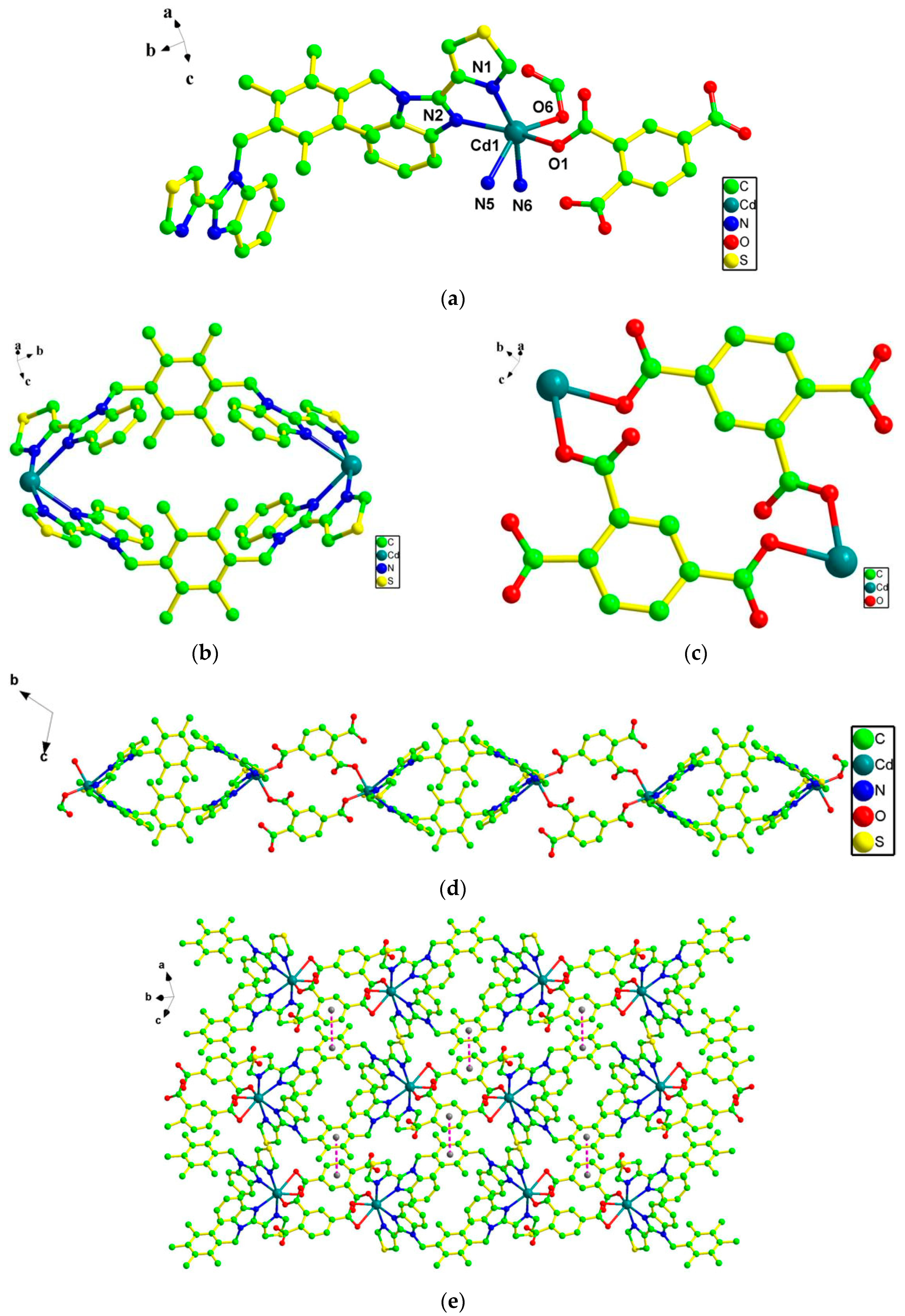


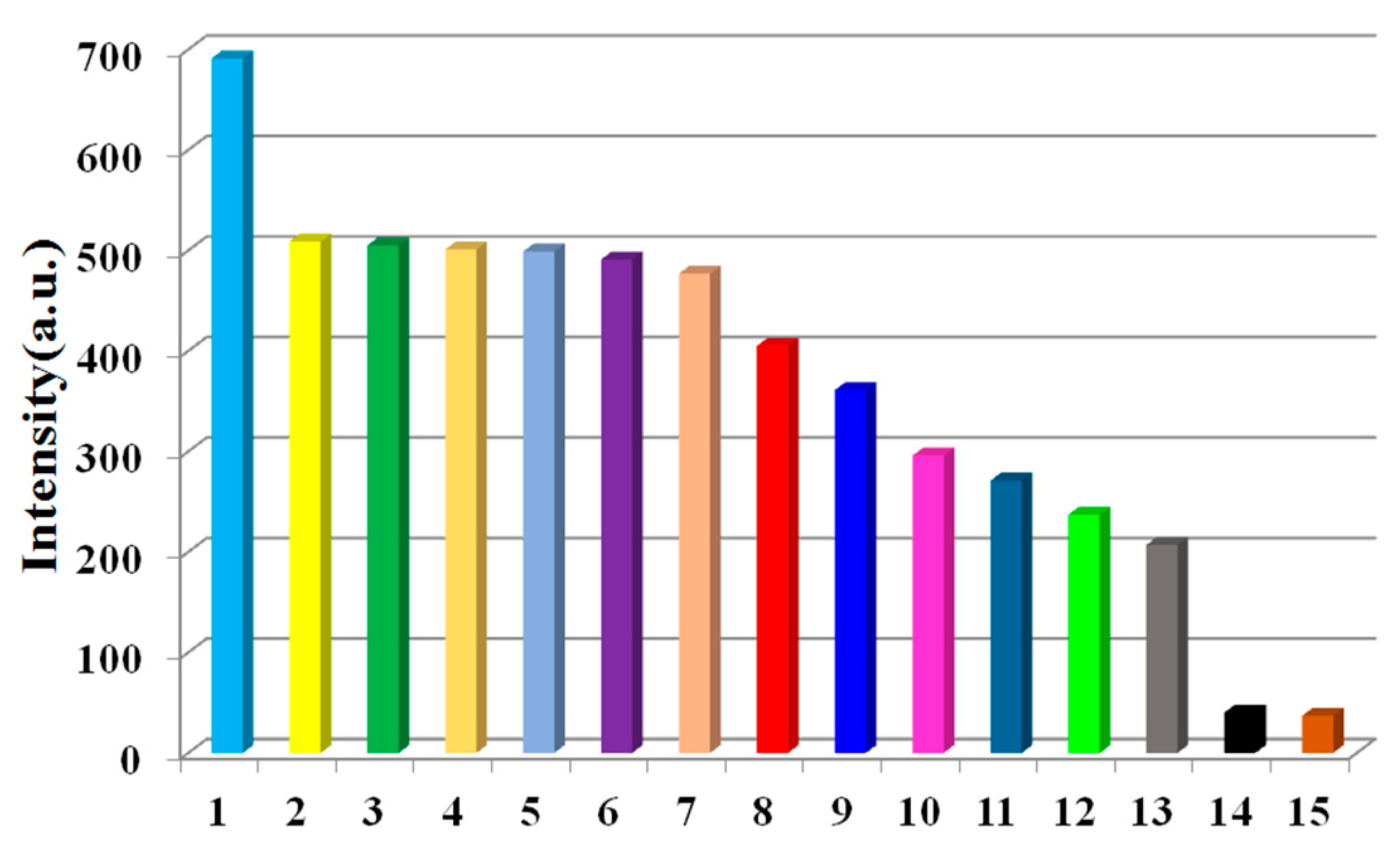
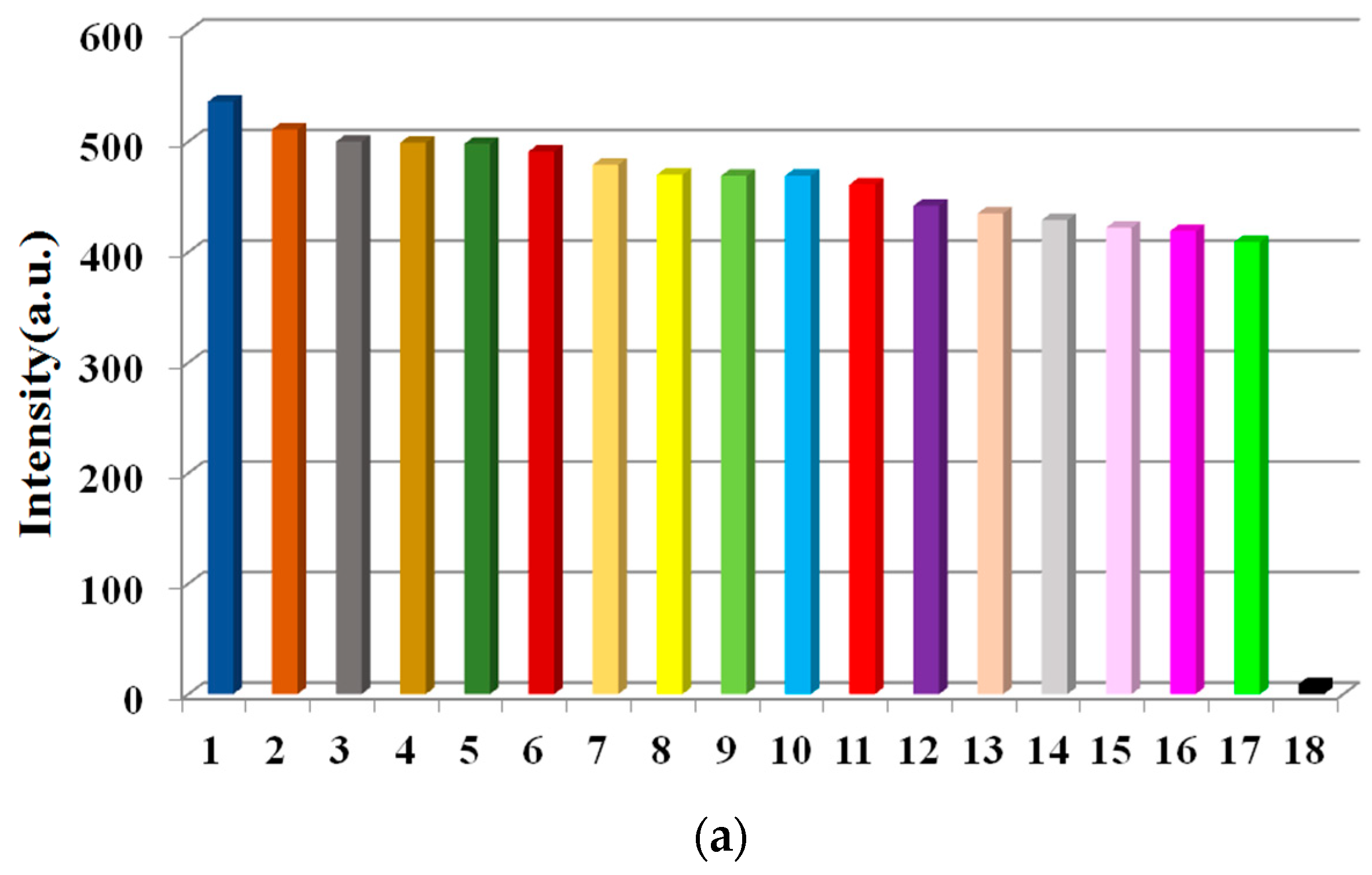
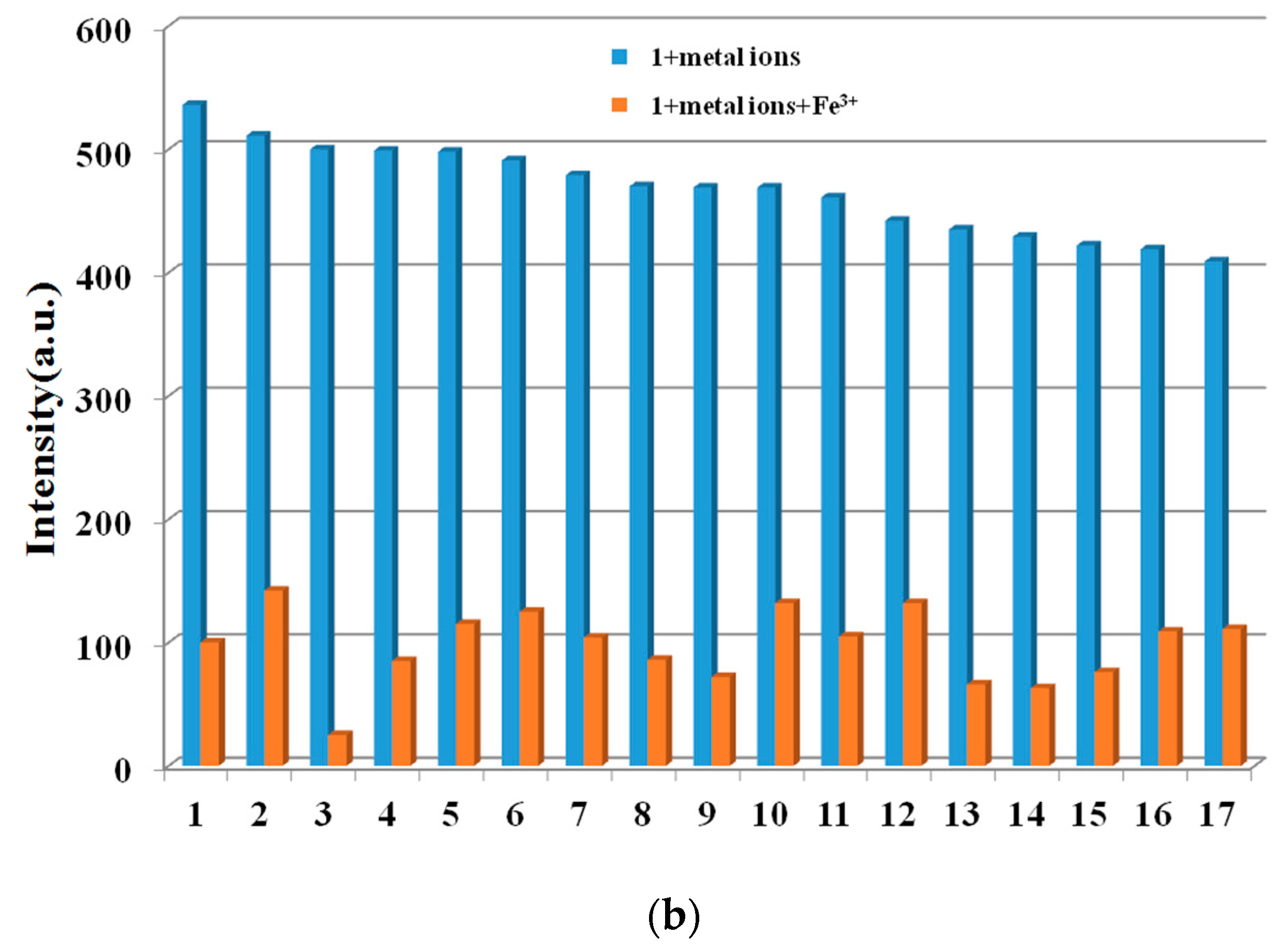
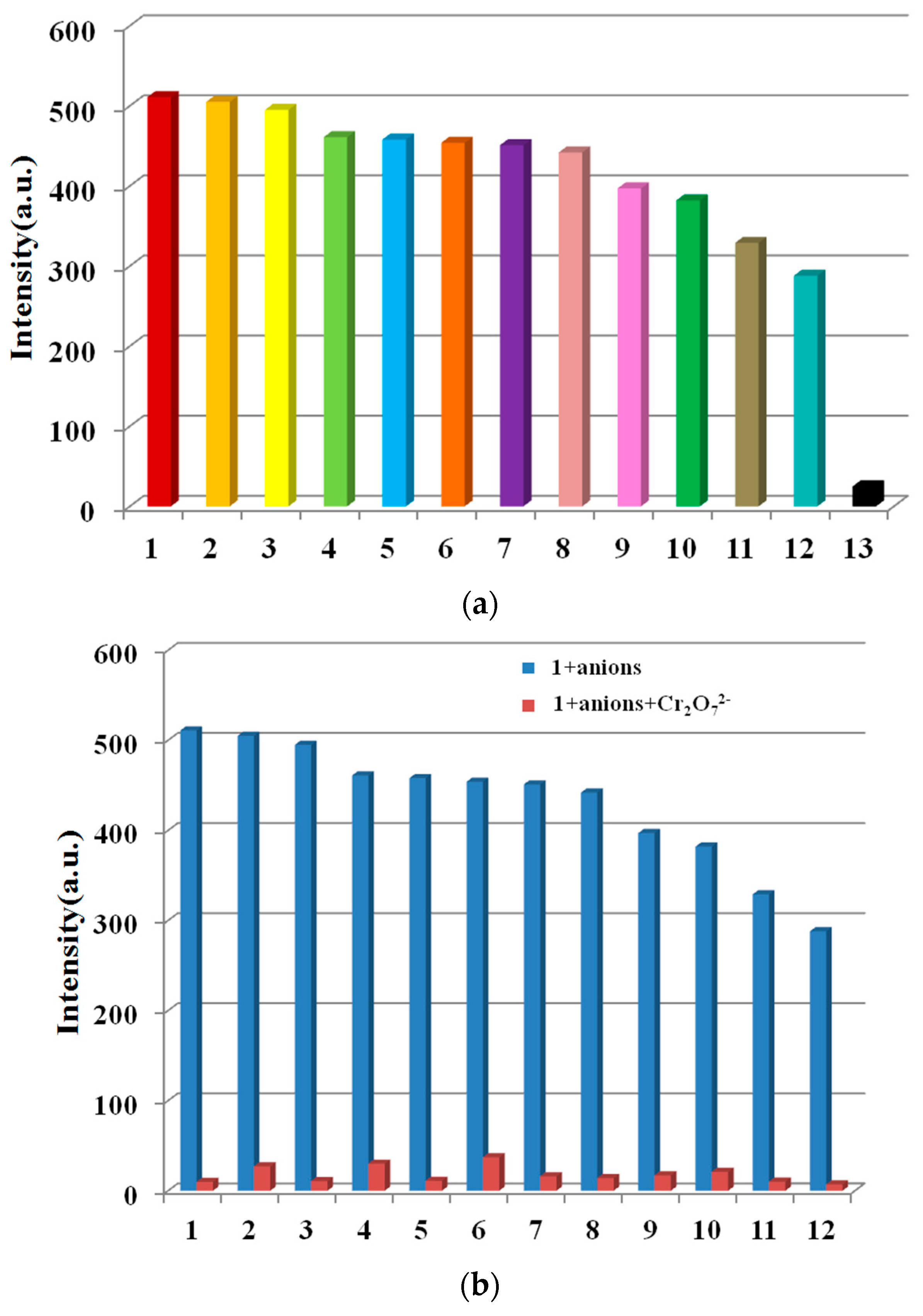
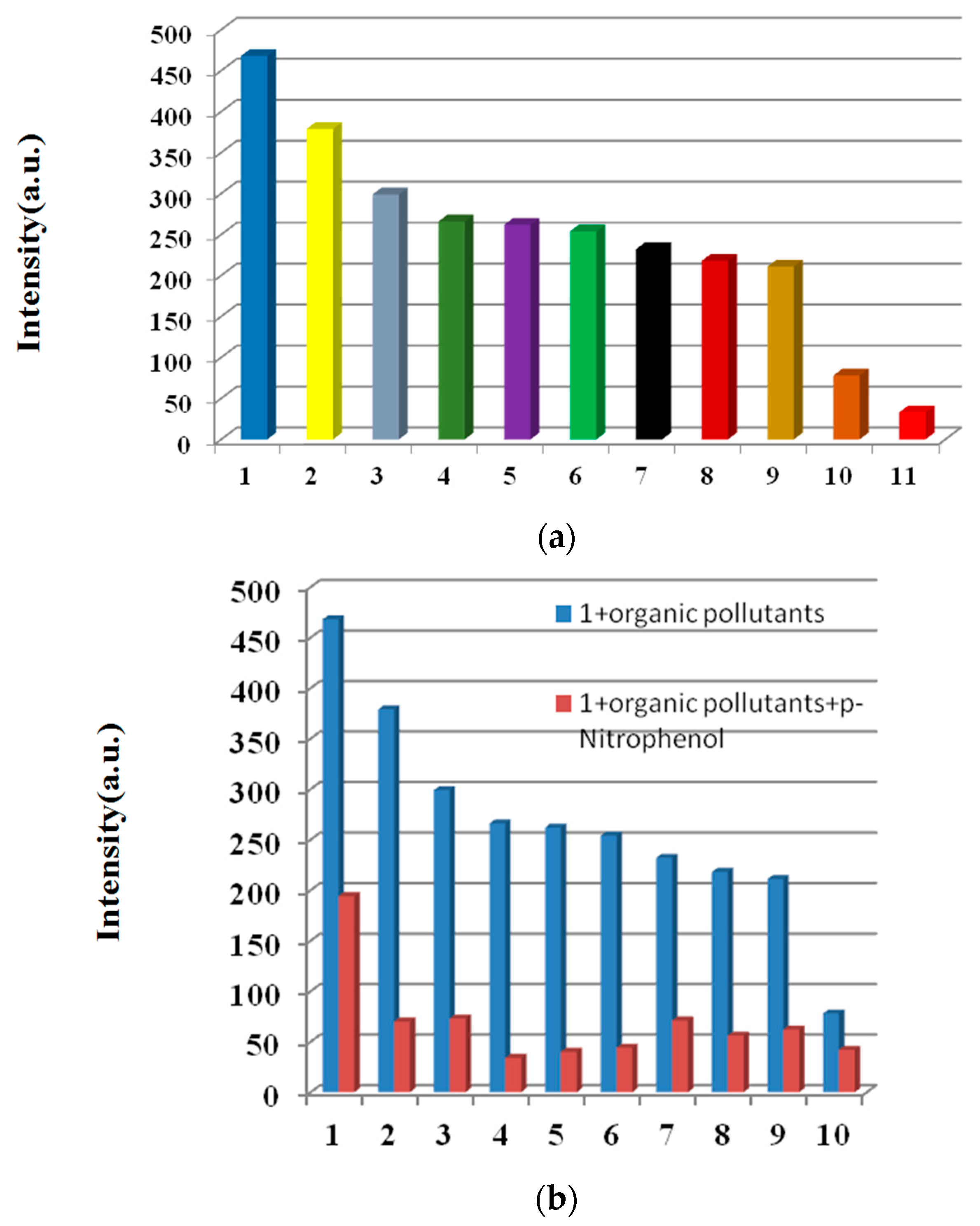

Disclaimer/Publisher’s Note: The statements, opinions and data contained in all publications are solely those of the individual author(s) and contributor(s) and not of MDPI and/or the editor(s). MDPI and/or the editor(s) disclaim responsibility for any injury to people or property resulting from any ideas, methods, instructions or products referred to in the content. |
© 2023 by the authors. Licensee MDPI, Basel, Switzerland. This article is an open access article distributed under the terms and conditions of the Creative Commons Attribution (CC BY) license (https://creativecommons.org/licenses/by/4.0/).
Share and Cite
Liu, L.; Li, J.-M.; Wang, H.-J.; Zhang, M.-D.; Xi, Y.; Xu, J.; Huang, Y.-Y.; Zhang, B.; Li, Y.; Zhang, Z.-B.; et al. Study on Fluorescence Recognition of Fe3+, Cr2O72− and p-Nitrophenol by a Cadmium Complex and Related Mechanism. Molecules 2023, 28, 1848. https://doi.org/10.3390/molecules28041848
Liu L, Li J-M, Wang H-J, Zhang M-D, Xi Y, Xu J, Huang Y-Y, Zhang B, Li Y, Zhang Z-B, et al. Study on Fluorescence Recognition of Fe3+, Cr2O72− and p-Nitrophenol by a Cadmium Complex and Related Mechanism. Molecules. 2023; 28(4):1848. https://doi.org/10.3390/molecules28041848
Chicago/Turabian StyleLiu, Lu, Jian-Min Li, Hui-Jie Wang, Meng-Di Zhang, Yu Xi, Jie Xu, Yuan-Yuan Huang, Bo Zhang, Ying Li, Zhen-Bei Zhang, and et al. 2023. "Study on Fluorescence Recognition of Fe3+, Cr2O72− and p-Nitrophenol by a Cadmium Complex and Related Mechanism" Molecules 28, no. 4: 1848. https://doi.org/10.3390/molecules28041848
APA StyleLiu, L., Li, J.-M., Wang, H.-J., Zhang, M.-D., Xi, Y., Xu, J., Huang, Y.-Y., Zhang, B., Li, Y., Zhang, Z.-B., Zhao, Z.-F., & Cui, C.-X. (2023). Study on Fluorescence Recognition of Fe3+, Cr2O72− and p-Nitrophenol by a Cadmium Complex and Related Mechanism. Molecules, 28(4), 1848. https://doi.org/10.3390/molecules28041848





